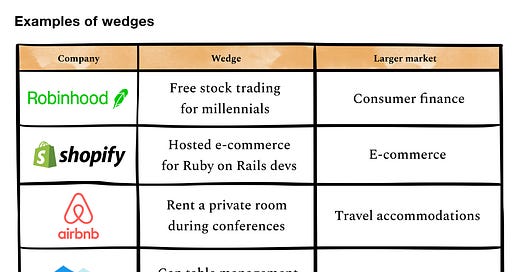👋 Hey, Lenny here! Welcome to a 🔒 subscriber-only edition 🔒 of my weekly newsletter. Each week I tackle reader questions about product, growth, working with humans, and anything else that’s stressing you out about work. Send me your questions and in return I’ll humbly offer actionable real-talk advice. Now, on to this week’s question…
Q: I’m hearing from investors that I need a wedge, to narrow our product focus and our GTM. What exactly is a wedge, and how do I pick the right wedge?
Whenever I think of wedges, I think of this guy:
A wedge in business is the same idea—you drive a wedge into the market and then use that wedge to win the market:
Twilio started with an API to send SMSs and is now the de facto communication API platform, worth over $60B. Airbnb started out allowing people to rent their extra rooms and now accounts for a fifth of the $90B vacation rental market. Amazon started out selling books and now represents about 40% of all U.S. e-commerce. If these companies had gone at their massive markets head-on, they’d arguably have had a much harder time. But by using a wedge strategy—focusing all their energy at one precise point—they were able to break in, build momentum, and win.
“The wedge metaphor to me is most useful in making sure you’re not a blunt instrument trying to chop into a market by being everything for everyone, but instead the sharp blade with extraordinary focus on a specific persona/use case to start.”
—Sarah Tavel, GP at Benchmark
What exactly is a wedge?
A wedge is simply a strategy to win a large market by initially capturing (1) a tiny part of a larger market or (2) a large part of a small adjacent market.
In business, as in rock cutting, a wedge is made up of two parts: (1) the right tool and (2) the right place to strike. In other words, the right initial product and the right initial market.
Tesla’s wedge (into the larger transportation market) was a luxury car targeted at affluent early adopters. Robinhood’s wedge (into the consumer finance market) was a commission-free trading platform targeted at millennials. PayPal’s wedge (into the payments market) was an online payment platform for eBay sellers.
Do I always need a wedge?
I don’t think so. Companies like Zoom, Slack, Workday, Notion, Datadog, Spotify, and Peloton went straight at their respective (large) markets with an amazing product and won. You can argue about semantics, but in practical terms, as far as I can tell, these companies didn’t use a wedge strategy—they attacked a large market straight-on.
“We kept hearing that to enter a big market, you need a wedge—something really sharp and really specific, and then you expand from there. It turns out for some classes of problems, such as infrastructure management, which is what we do, the wedge doesn’t work. There is a large amount of stuff you need to do from day one if you want your product to be useful. Our initial product was positioned as a very broad platform to bring multiple teams together, and actually didn’t have that wedge aspect. That disconcerted some investors.”
—Olivier Pomel, CEO and co-founder of Datadog (source)
When do I need a wedge?
A wedge seems most essential when you’re going after a market that is (1) entrenched or (2) crowded. When it’s hard to break in head-on.








